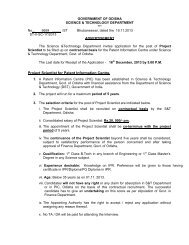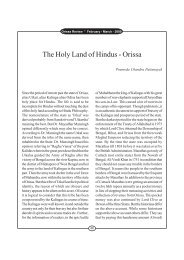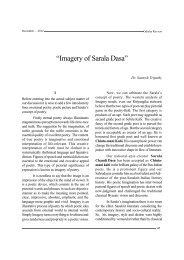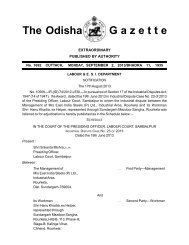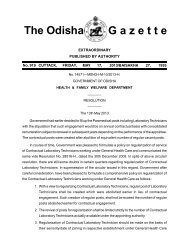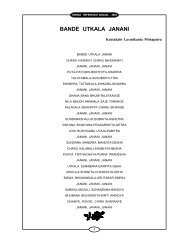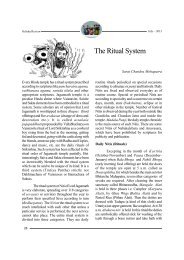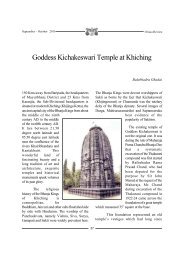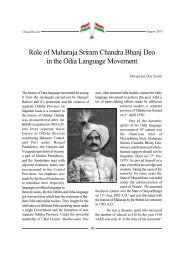A Fascinating Study of Syncretic Culture in Orissa
A Fascinating Study of Syncretic Culture in Orissa
A Fascinating Study of Syncretic Culture in Orissa
You also want an ePaper? Increase the reach of your titles
YUMPU automatically turns print PDFs into web optimized ePapers that Google loves.
<strong>Orissa</strong> Review<br />
A <strong>Fasc<strong>in</strong>at<strong>in</strong>g</strong><br />
<strong>Study</strong> <strong>of</strong><br />
<strong>Syncretic</strong><br />
<strong>Culture</strong> <strong>in</strong><br />
<strong>Orissa</strong><br />
Introduction :<br />
The new Islamic<br />
<strong>Culture</strong> was <strong>in</strong>troduced <strong>in</strong> India<br />
by the Arabs <strong>in</strong> North India.<br />
The expansion <strong>of</strong> Muslim<br />
culture was attempted by<br />
means <strong>of</strong> peace and aggression.<br />
Peaceful means was followed<br />
by the Arab traders and Muslim<br />
Sa<strong>in</strong>ts (Dervishes). Aggression<br />
means was adopted by Arab,<br />
Afghan, Turk and Mughal<br />
<strong>in</strong>vaders. Apparently rise and<br />
expansion <strong>of</strong> Islam constitute a<br />
most fasc<strong>in</strong>at<strong>in</strong>g episode <strong>in</strong> the<br />
history <strong>of</strong> mank<strong>in</strong>d. A proper<br />
understand<strong>in</strong>g <strong>of</strong> the historical<br />
role <strong>of</strong> Islam and the<br />
contribution it has made to<br />
human culture has required<br />
supreme importance.<br />
26<br />
Dr. Mohammed Yam<strong>in</strong><br />
In 636 C.E. Arab fleet<br />
first appeared <strong>in</strong> Indian water<br />
and made some settlement<br />
across the Indian coast.<br />
Accord<strong>in</strong>g to Rawldanso and<br />
Francis Day that Arab Muslim<br />
first settled on the Malbar<br />
Coast about the end <strong>of</strong> 7 th<br />
century C.E. In the last quarter<br />
<strong>of</strong> the 8 th century C.E. Arab<br />
aga<strong>in</strong> attacked Broach and<br />
other harbour <strong>of</strong> the Kathiawar<br />
coast. Then trade began to<br />
flourish and settlement<br />
cont<strong>in</strong>ued to multiply. They<br />
acquired property and<br />
<strong>in</strong>dependently followed their<br />
religion. After the demise <strong>of</strong><br />
Prophet Mohammed (570 to<br />
632 C.E.) with<strong>in</strong> a century the<br />
Arab subjugated extensive<br />
territory. It was <strong>in</strong> 711-13 a<br />
young Arab military general<br />
Mohammed.-b<strong>in</strong>-Qasim<br />
conquered S<strong>in</strong>dh and Multan.<br />
Politically that conquest was<br />
<strong>in</strong>significant, yet it had farreach<strong>in</strong>g<br />
effects on Muslim<br />
culture though Islam bears<br />
some impressionable lesson<br />
from the Indian soil.<br />
The whole process <strong>of</strong><br />
conquest and consolidation<br />
was completed by Sultanate<br />
ruler and <strong>in</strong> the 16 th century<br />
C.E. India was extensively<br />
gone to the control <strong>of</strong> Mughal.<br />
At that time <strong>Orissa</strong> was<br />
occupied by Sulaiman Karani<br />
<strong>in</strong> 1568 C.E by defeat<strong>in</strong>g<br />
Mukunda Dev (the last H<strong>in</strong>du<br />
ruler <strong>of</strong> <strong>Orissa</strong>). This was for<br />
the first time <strong>Orissa</strong> (extensively<br />
a H<strong>in</strong>du dom<strong>in</strong>ated prov<strong>in</strong>ce)<br />
came under an <strong>in</strong>vaders<br />
<strong>in</strong>fluence. From that period<br />
onwards <strong>Orissa</strong> was directly or<br />
<strong>in</strong>directly occupied by the<br />
Muslim Rulers who ruled it<br />
through their appo<strong>in</strong>ted<br />
Subedar and adm<strong>in</strong>istrator. The<br />
rule <strong>of</strong> Muslim over <strong>Orissa</strong><br />
<strong>in</strong>fluences it <strong>in</strong> various ways.<br />
Therefore, the Muslim effect<br />
directly fell on the life and<br />
culture <strong>of</strong> the common men viz.,<br />
society, religion, economy and<br />
literature.<br />
Society :<br />
Islam came to India<br />
after it had played out its<br />
progressive role. Its leadership<br />
had been wrested on the<br />
learned and cultured Arabs. As<br />
regards the spread <strong>of</strong> Islam <strong>in</strong><br />
India no great people with a<br />
long history and old civilization<br />
can ever succumb easily to a<br />
foreign <strong>in</strong>vasion unless the<br />
<strong>in</strong>vaders command the<br />
sympathy and acquiescence.<br />
Islam brought a new pattern <strong>of</strong><br />
life. The common mass was<br />
attracted by the social system<br />
<strong>of</strong> Islam. It gives every true<br />
believer equal spiritual status.<br />
There were many positive<br />
results <strong>of</strong> the <strong>in</strong>teraction<br />
between H<strong>in</strong>du-Muslim. But<br />
their results were neither<br />
acceptable to orthodox H<strong>in</strong>dus<br />
September - 2010
nor orthodox Muslims. In spite<br />
<strong>of</strong> opposition, assimilation did<br />
take place. Purdah or veil<br />
system, seclusion <strong>of</strong> women<br />
folk was <strong>in</strong>troduced<br />
elaborately. In case, they<br />
moved outside they used<br />
palanqu<strong>in</strong>s covered with<br />
curta<strong>in</strong>s. We have reference <strong>of</strong><br />
the queen <strong>of</strong> Raja Rudra Pratap<br />
<strong>of</strong> Puri who used to visit Sri<br />
Chaitanya <strong>in</strong> covered<br />
palanqu<strong>in</strong>s. Muslims adopted<br />
local habits <strong>of</strong> eat<strong>in</strong>g and<br />
dr<strong>in</strong>k<strong>in</strong>g. A number <strong>of</strong> social<br />
taboos and restriction<br />
regard<strong>in</strong>g caste among the<br />
H<strong>in</strong>dus helped Islam to<br />
attract<strong>in</strong>g lower section <strong>of</strong><br />
society. Missionary zeal <strong>of</strong><br />
Islam also helped spread the<br />
new religion. It was not liked<br />
by the orthodox H<strong>in</strong>dus <strong>in</strong><br />
<strong>Orissa</strong>. Due to the impact <strong>of</strong><br />
Islam, chastity <strong>of</strong> women<br />
valued, the custom <strong>of</strong> Jauhar<br />
and Sati were restricted.<br />
In custom, manner,<br />
dress, etiquette, food and<br />
ceremony Islam left permanent<br />
mark <strong>in</strong> the society <strong>of</strong> <strong>Orissa</strong>.<br />
Popular dresses like<br />
Archakan, Salwar, Jama,<br />
Paijama, Rumal, Shawl,<br />
Takia, etc, are <strong>of</strong> Muslim orig<strong>in</strong>.<br />
Fruits like, Kishmis, Pesta,<br />
Badam, Angur, Annar, etc<br />
were brought to <strong>Orissa</strong> by the<br />
Muslims. Ornaments like<br />
Bajuband and Kamarband,<br />
the use <strong>of</strong> Paper, Pen, and<br />
September - 2010<br />
Scent etc. were <strong>in</strong>troduced by<br />
the Muslims. Samputas food<br />
like Biriani, Palau, Chapati,<br />
Jalebi, Halwa and other meat<br />
preparation are <strong>of</strong> Muslim<br />
<strong>in</strong>fluence. Many places <strong>in</strong><br />
<strong>Orissa</strong> were renamed by<br />
Muslim <strong>in</strong> their own which are<br />
still <strong>in</strong> use by present people <strong>in</strong><br />
<strong>Orissa</strong> viz Rasulgarh, Rasulpur,<br />
Ahmad Nagar, Mohammedpura,<br />
etc.<br />
Religion :<br />
In the pre-Muslim<br />
period H<strong>in</strong>duism <strong>in</strong> its various<br />
creeds and forms was<br />
manifested <strong>in</strong> the construction<br />
<strong>of</strong> many temples. All religious<br />
th<strong>in</strong>k<strong>in</strong>g and spiritual atta<strong>in</strong>ment<br />
gathered a form <strong>of</strong> synthesis<br />
under the <strong>in</strong>stitution <strong>of</strong> Lord<br />
Jagannath. The concept <strong>of</strong><br />
Patitapaban, it is believed,<br />
developed as a result <strong>of</strong> Muslim<br />
<strong>in</strong>fluence. Muslim migration to<br />
<strong>Orissa</strong> cont<strong>in</strong>ued after its<br />
conquest and they exploited<br />
the liberal social set up <strong>of</strong> <strong>Orissa</strong><br />
and managed to set up their<br />
own religious places, like<br />
Mosque, Madrassa, Maqtab,<br />
Tomb and Shr<strong>in</strong>es. first at<br />
Cuttack and later on other<br />
places <strong>of</strong> <strong>Orissa</strong>.<br />
Satyapir cult became<br />
popular <strong>in</strong> <strong>Orissa</strong> due to the<br />
<strong>in</strong>fluence <strong>of</strong> Muslim. Common<br />
worship <strong>of</strong> the common folk <strong>of</strong><br />
the two communities- Satyapir<br />
<strong>Orissa</strong> Review<br />
began <strong>in</strong> 16h century C.E.<br />
dur<strong>in</strong>g Hussa<strong>in</strong> Shahi dynasty<br />
(1494-1538). In <strong>Orissa</strong><br />
Satyapir worship became<br />
popular <strong>in</strong> 18th century C.E.<br />
Islam gave <strong>Orissa</strong> the message<br />
<strong>of</strong> universal brotherhood,<br />
equality <strong>in</strong> society, outrightly<br />
rejected caste system and<br />
untouchability. These pr<strong>in</strong>ciples<br />
consciously or unconsciously<br />
had a great impression upon the<br />
philosophical H<strong>in</strong>du m<strong>in</strong>d and<br />
found place <strong>in</strong> Jagannath cult.<br />
The pre-Islamic<br />
practice <strong>in</strong> <strong>Orissa</strong> <strong>of</strong> the Babas,<br />
Gurus, Sanyasis, and Bairagis<br />
helped sympathetic period for<br />
the acceptance <strong>of</strong> Muslim<br />
equivalents <strong>of</strong> the Satyapirs.<br />
The shr<strong>in</strong>es <strong>of</strong> Bhujakhiapir at<br />
Balasore, Qadam-i-Rasool at<br />
Cuttack, Noor Bibi Mazaar at<br />
Sambalpur, Abdul Sakoor<br />
shr<strong>in</strong>e at Tarbha are the centres<br />
<strong>of</strong> spiritual solace for the<br />
people <strong>of</strong> <strong>Orissa</strong>. These sa<strong>in</strong>ts<br />
were very popular amongst the<br />
masses. The members <strong>of</strong> the<br />
order were called Fakir,<br />
mendicant or dervishes. Some<br />
<strong>of</strong> the ceremonies and rituals<br />
which came with Islam were<br />
regarded as auspicious and<br />
which were gladly accepted by<br />
the Oriyas. One example is<br />
Tajia or Muharram procession.<br />
Some <strong>of</strong> these were sponsored<br />
by local elite. The concept <strong>of</strong><br />
Nirakar is not new to <strong>Orissa</strong> but<br />
it had its echo <strong>in</strong> the writ<strong>in</strong>g <strong>of</strong><br />
27
<strong>Orissa</strong> Review<br />
Pancha Sakha (five associates)<br />
after the spread <strong>of</strong> Islam <strong>in</strong><br />
<strong>Orissa</strong>. These languages are<br />
highly mean<strong>in</strong>gful, symbolic and<br />
esoteric. They established their<br />
Pitha or centre alo<strong>of</strong> from the<br />
political power like the Sufi<br />
Sa<strong>in</strong>ts. In this backdrop it is no<br />
wonder that Sufism found easy<br />
adherence <strong>in</strong> <strong>Orissa</strong>. The<br />
Panch Sakhas predicted the<br />
end <strong>of</strong> Kaliyuga and com<strong>in</strong>g <strong>of</strong><br />
Kalki Avatara and Satyayuga<br />
like the Sufi belief that the<br />
Millennium or Dooms day was<br />
approach<strong>in</strong>g for the restoration<br />
<strong>of</strong> orig<strong>in</strong>al faith <strong>of</strong> Islam.<br />
Economy :<br />
Agriculture played a<br />
dom<strong>in</strong>ant role <strong>in</strong> <strong>Orissa</strong>n<br />
economy. The fertile soil and<br />
moderate ra<strong>in</strong>fall <strong>of</strong> <strong>Orissa</strong><br />
encouraged production. So,<br />
agriculture was <strong>in</strong> a flourish<strong>in</strong>g<br />
condition. Simultaneously<br />
different rivers served to irrigate<br />
and fertilise <strong>Orissa</strong>. Muslims<br />
impact also witnessed <strong>in</strong> the<br />
food gra<strong>in</strong>s like : Rice,<br />
Vegetables, Fruits, Oil Seeds,<br />
Spices, Cash Crops,<br />
Sericulture, Dairy <strong>in</strong>dustries<br />
and other Non-Agricultural<br />
products. Muslim component <strong>in</strong><br />
peasant population grew <strong>in</strong><br />
number. The liv<strong>in</strong>g pattern <strong>of</strong><br />
both H<strong>in</strong>dus and Muslims<br />
cultivators were identical <strong>in</strong><br />
<strong>Orissa</strong>n rural society.<br />
28<br />
Literature :<br />
A number <strong>of</strong> Islamic<br />
literatures took shape <strong>in</strong> <strong>Orissa</strong>.<br />
The orig<strong>in</strong>al works <strong>of</strong> Arabic,<br />
Parsi, Turkish and even Urdu<br />
were translated <strong>in</strong>to Oriya<br />
Language. Khwaja Ma<strong>in</strong>udd<strong>in</strong>-<br />
Chisti (Sufi Sa<strong>in</strong>t) <strong>of</strong> Ajmer<br />
primarily encouraged the<br />
spread <strong>of</strong> Parsi language <strong>in</strong><br />
India. Dur<strong>in</strong>g Muslim rule <strong>in</strong><br />
<strong>Orissa</strong> Parsi language was<br />
spoken and <strong>of</strong>ficial records<br />
ma<strong>in</strong>ta<strong>in</strong>ed <strong>in</strong> Parsi. Poems <strong>of</strong><br />
poet Abhimanyu Samant<br />
S<strong>in</strong>ghar, Baldev Rath, Upendra<br />
Bhanja mark the <strong>in</strong>fluence <strong>of</strong><br />
Parsi, Arabic and Urdu<br />
languages. Islam had direct<br />
impact on Fakir Mohan. He<br />
was named Fakir because his<br />
grandmother symbolically sold<br />
him to a Muslim Fakir or<br />
Dervishes. In his childhood<br />
Fakir Mohan used to collect<br />
alms as a Fakir boy and from<br />
the begged he used to prepare<br />
Sirni and distributed to the poor<br />
<strong>in</strong> the name <strong>of</strong> Satyapir.<br />
Pala :<br />
18 th Century marks the<br />
growth <strong>of</strong> Satyapir sect. It was<br />
manifestation <strong>of</strong> H<strong>in</strong>du-Muslim<br />
unity. This century also<br />
witnessed the rise <strong>of</strong> Pala. Kabi<br />
Karna was the founder <strong>of</strong> Pala<br />
literature. It had a series <strong>of</strong> 16<br />
books one <strong>of</strong> which depicted<br />
the miracle <strong>of</strong> Satyapir. Pala is<br />
divided <strong>in</strong>to two types viz.<br />
I. Baithaki Pala and<br />
II. Thia Pala.<br />
Tamasa and Jatra :<br />
In the second quarter<br />
<strong>of</strong> the 18 th Century poet<br />
Bansiballav Goswami wrote the<br />
Tamasa. He synthesized<br />
Islamic tenet with Oriya<br />
literature. The tradition <strong>of</strong> Jatra<br />
was very much prevalent <strong>in</strong><br />
<strong>Orissa</strong>. Historians believed<br />
that, Jatra is the sound impact<br />
<strong>of</strong> Islamic literature over<br />
<strong>Orissa</strong>. Poet Salabeg and Uzir<br />
Bag wrote hundreds <strong>of</strong> Bhajana<br />
on Jagannath and<br />
Radhakrishna Cult <strong>in</strong> Oriya<br />
literature. Parsian poet Saikh<br />
Sahdis (1194-1282) Pand<br />
Nama was translated <strong>in</strong>to Oriya<br />
by Abdul Majid Saheb <strong>of</strong><br />
Balasore <strong>in</strong> Prabodha Bakya or<br />
Hitapodesh Mala edited and<br />
published <strong>in</strong> 1869.<br />
Madhusudan Roy has written<br />
a series <strong>of</strong> books on Muslim<br />
Prophet and Sa<strong>in</strong>ts. Qawali<br />
and Ghazal are examples <strong>of</strong> the<br />
impact <strong>of</strong> Islam <strong>in</strong> Oriya<br />
literature and language.<br />
Countless words <strong>of</strong> Parsian,<br />
Arabic, Urdu and Turkish<br />
entered <strong>in</strong>to Oriya Vocabulary<br />
and were assimilated <strong>in</strong> the<br />
spoken language <strong>of</strong> the<br />
common mass. Oriya poets<br />
September - 2010
used the work <strong>in</strong> their Kavya<br />
or poems. <strong>Orissa</strong>n society<br />
reflected a sense <strong>of</strong> hospitality<br />
to the strangers which deserves<br />
merits. Culturally, Islam had its<br />
unique and remarkable<br />
contribution. It brought some<br />
new idea and some new<br />
problems, but left a legacy, that<br />
is successfully utilized by the<br />
succeed<strong>in</strong>g generation for ever.<br />
Bibliography :<br />
B. Acharya, Oriya Sahityara<br />
Itihasa, (Oriya), Cuttack, 1969.<br />
September - 2010<br />
B.C. Roy, <strong>Orissa</strong> under the<br />
Mughals. Punthi Pustak, Culcutta,<br />
1981.<br />
C.L. Fabri, History <strong>of</strong> the Art <strong>of</strong><br />
<strong>Orissa</strong>, Orient Longman, Bombay,<br />
1974.<br />
H. K. Mahatab, History <strong>of</strong> <strong>Orissa</strong>,<br />
Lucknow, 1949.<br />
J. Sarkar, History <strong>of</strong> Aurangzeb,<br />
M.C. Sarkar, Calcutta, 1924<br />
M. Yam<strong>in</strong>, Impact <strong>of</strong> Islam on<br />
<strong>Orissa</strong>n <strong>Culture</strong>, Readworthy, New<br />
Delhi, 2009.<br />
M. A. Haque, Muslim<br />
Adm<strong>in</strong>istration <strong>in</strong> <strong>Orissa</strong> 1568-<br />
151, Punthi Pustak, Calcutta, 1980.<br />
Hon'ble Chief M<strong>in</strong>ister Shri Naveen Patnaik review<strong>in</strong>g various<br />
schemes <strong>of</strong> Tourism Department at Secretariat on 25.8.2010.<br />
<strong>Orissa</strong> Review<br />
R.D. Banerji, History <strong>of</strong> <strong>Orissa</strong>, R.<br />
Chatterjee, Culcutta, 1930.<br />
Dr. Mohammed Yam<strong>in</strong> is the Head,<br />
Deptt. <strong>of</strong> History, C.J.D. College,<br />
Borda, Kalahandi- 766036, e-mail<br />
mail2mdyam<strong>in</strong>@yahoo.co.<strong>in</strong><br />
29



